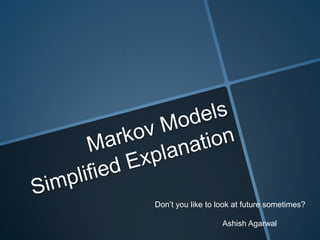
Markov models explained
- 1. Don’t you like to look at future sometimes? Ashish Agarwal
- 2. Markov models are mathematical models based on the property of Markov process What is a Markov process? Markov process analyzes a set of random, dependent events which depend on what happened last. e.g. 1. A Markov model could be to look at a long sequence of rainy, sunny & foggy days in a particular region & try to predict what the weather will be tomorrow. e.g. 2. Tossing a coin that gathers a sequence of Heads & Tails & then tries to predict what will appear next is NOT a Markov model because tossing a coin to get a Head or a Tail are independent events. Markov Models are applicable ONLY for dependent events.
- 3. Markov Process Example in detail Problem Statement: Suppose you want to predict what the weather will be like tomorrow based on what the weather is today. This can be expressed in terms of probability as – P(w tomorrow | w today ) The above expression is read as – Probability of tomorrow’s weather given today’s weather Now suppose we arbitrarily pick the following values for P(w tomorrow | w today ) Tomorrow’s weather Sunny Rainy Foggy Today’s Sunny 0.8 0.05 0.15 weather Rainy 0.2 0.6 0.2 Foggy 0.2 0.3 0.5
- 4. Tomorrow’s weather Sunny Rainy Foggy Today’s weather Sunny 0.8 0.05 0.15 Rainy 0.2 0.6 0.2 Foggy 0.2 0.3 0.5 0.2 0.5 0.8 0.15 0.05 0.3 Finite State 0.2 0.2 Diagram 0.6
- 5. Question: Given that today is Sunny (w1), what’s the probability that tomorrow is sunny (w2) and the day after is rainy (w3)? P( w2 = sunny, w3=rainy | w1 = sunny) = ? The probability table (copied from previous slide) Tomorrow’s weather Sunny Rainy Foggy Today’s weather Sunny 0.8 0.05 0.15 Rainy 0.2 0.6 0.2 Foggy 0.2 0.3 0.5 P( w2=sunny, w3=rainy | w1=sunny) = P (w2=sunny| w1=sunny) * P (w3=rainy| w2=sunny, w1=sunny) = 0.8 * 0.05 = 0.04
- 6. Where do we use Markov Models (MM)? 1. Speech Recognition 2. Bio Informatics 3. Face Expression Characterizations 4. Harry F. Olson at Bell Labs used MM to generate music by analyzing 11 songs of Foster
